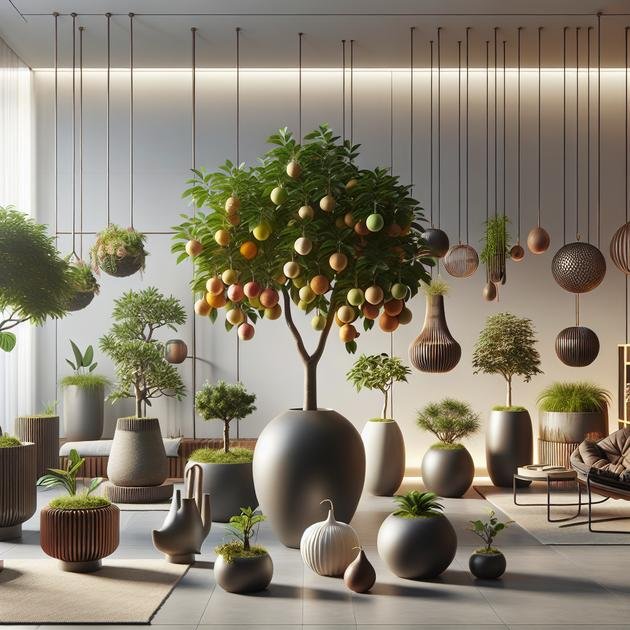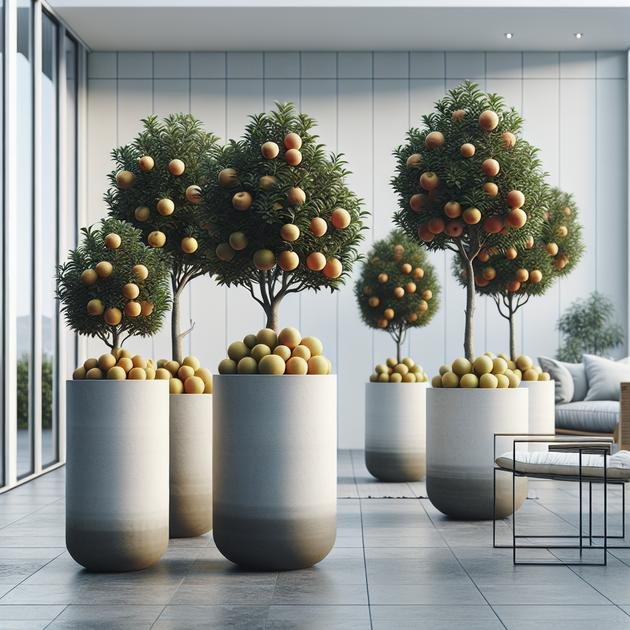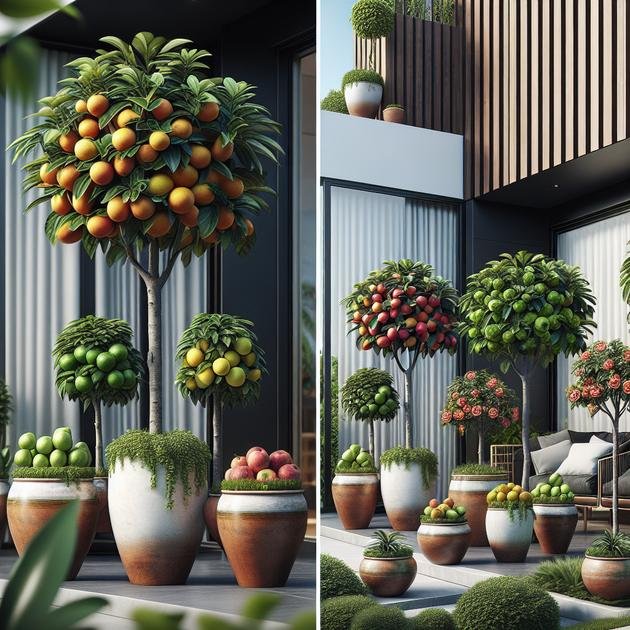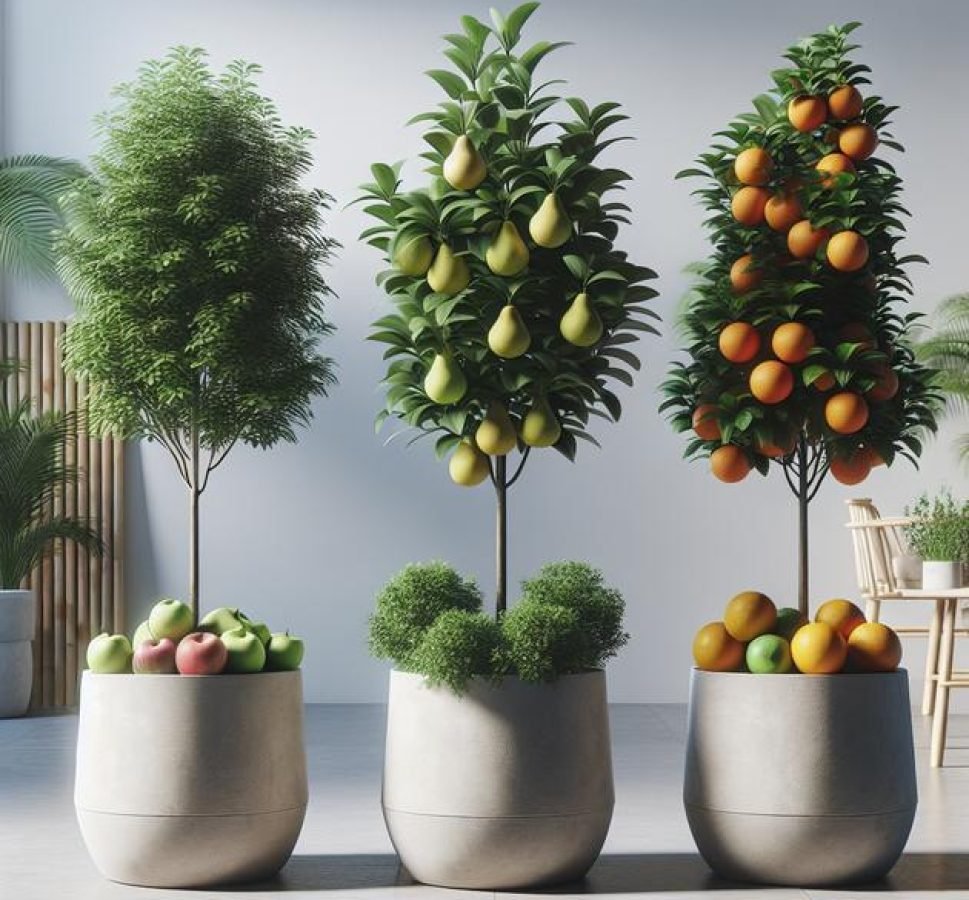Fruit trees in pots offer a flexible way to grow fresh fruit in small spaces by selecting dwarf varieties, using proper soil and watering, ensuring adequate sunlight, and regular pruning and pest management to maintain healthy, productive plants.
Fruit trees in pots can transform your home into a mini orchard, no matter the space you have. Curious about how to make them thrive and bring juicy rewards? Let’s dive into tips and tricks that really work.
why choose fruit trees in pots
Choosing fruit trees in pots offers a flexible and rewarding way to grow your own fresh produce, especially if you have limited space. Potted fruit trees are perfect for balconies, patios, or small gardens where in-ground planting isn’t an option. They allow you to move your plants to follow sunlight or protect them from harsh weather conditions.
Another benefit is the ease of controlling soil quality and watering, which can help your fruit trees thrive in less-than-ideal soil. Plus, container gardening often reduces the risk of pests and diseases compared to ground planting.
Fruit trees in pots also provide an aesthetic boost to your outdoor space. You can mix and match different trees and pots to suit your style and create a personal oasis. It’s a practical way to enjoy fresh fruit even in urban settings, making growing your own food accessible and convenient.
Whether you’re a gardening beginner or an experienced grower, fruit trees in pots bring versatility and charm to your green spaces.
best fruit tree varieties for containers
Choosing the right fruit tree varieties for containers is key to success. Dwarf and semi-dwarf varieties are ideal since they remain small and manageable. Citrus trees like lemons, limes, and mandarins do well in pots due to their compact size and ability to thrive in warmer climates.
Other excellent choices include fig trees, which tolerate container growth and produce sweet fruits. Blueberry bushes and strawberries are great alternatives for smaller containers, offering delicious berries with minimal space.
Look for trees specifically labeled as suitable for container growing to ensure healthy growth and better fruit yield. It’s important to pick varieties that match your climate and sunlight availability, as this improves the chances of thriving plants.
Popular container-friendly fruit trees include Meyer lemon, Dwarf apple, Dwarf peach, and Alpine strawberry. With the right variety, even small spaces can become fruitful gardens.
how to select the right pot size
Selecting the right pot size is crucial for the healthy growth of fruit trees in pots. The pot should be large enough to support the tree’s roots but not so big that it holds excessive moisture, which can cause root rot.
Start with a pot that is at least 12 to 18 inches in diameter for young trees. As the tree grows, you may need to move it to a larger container to avoid root crowding. A good rule of thumb is to choose a pot that is about 2-4 inches wider in diameter than the current root ball.
Make sure the pot has drainage holes to allow excess water to escape. This prevents waterlogged soil, which can damage the roots and stunt growth. Consider the material of your pot as well; clay pots are breathable but heavier, while plastic pots are lighter but retain more moisture.
Proper pot size helps regulate moisture, encourages root development, and supports overall tree health, ensuring your fruit trees will flourish.
soil and fertilizer tips for potted fruit trees

Healthy soil is the foundation for thriving fruit trees in pots. Use a high-quality potting mix designed for containers, which holds moisture well but drains excess water to prevent root rot. Avoid garden soil, as it can be too dense and may contain pests or diseases.
Regular feeding is essential since nutrients leach out faster in pots. Use a balanced, slow-release fertilizer formulated for fruit trees, applied during the growing season to support steady growth and fruit production.
Organic options like compost or worm castings improve soil health and encourage beneficial microbes. Additionally, a monthly feed with a liquid fertilizer high in potassium helps promote blooming and fruit set.
Maintaining good soil structure and proper fertilization ensures your potted fruit trees get the nutrients they need to grow strong and produce abundant fruit.
watering essentials for healthy growth
Proper watering is vital for fruit trees in pots to stay healthy and productive. Container plants dry out faster than those in the ground, so regular watering is needed, especially during hot weather.
Check the soil moisture daily by sticking your finger about an inch deep. If it feels dry, it’s time to water. Water thoroughly until it drains from the bottom to ensure roots get enough moisture.
Overwatering can harm your tree by causing root rot, so avoid letting pots sit in standing water. Using pots with drainage holes helps prevent this issue. During cooler months, reduce watering frequency to avoid waterlogged soil.
Consistent, balanced watering keeps fruit trees vigorous, supports fruit development, and helps prevent stress that invites pests or diseases.
managing sunlight and temperature
Managing sunlight and temperature is crucial for the health and productivity of fruit trees in pots. Most fruit trees require at least 6 hours of direct sunlight daily to flourish. Place your pots in spots that receive adequate light, like south-facing balconies or patios.
Temperature fluctuations can stress the trees. During hot weather, move pots to shaded areas in the afternoon if possible or use shade cloth to protect them from scorching sun. In colder months, bring pots indoors or close to walls that retain heat to shield them from frost.
Consider the specific sunlight and temperature needs of your chosen fruit tree variety. Tropical fruit trees often need warmer climates, while apples and cherries can tolerate cooler temperatures.
Proper sunlight exposure and temperature control boost photosynthesis, fruit ripening, and overall tree vigor.
pruning techniques to boost fruit production
Pruning is essential to boost fruit production in potted fruit trees. Regular trimming helps shape the tree, remove dead or diseased branches, and increase light penetration and air circulation, which encourages healthy growth and more fruit.
Use sharp, clean pruning shears to make precise cuts just above a bud or branch junction. Focus on removing crowded or crossing branches to prevent damage and promote a strong framework.
Timing matters: prune most fruit trees during late winter or early spring before new growth starts. Summer pruning can also be done to control size and remove water sprouts.
Be careful not to over-prune, as removing too much foliage reduces the tree’s energy. Aim for a balanced approach that supports healthy leaf and fruit development.
Consistent pruning improves fruit size, quality, and yield while keeping your potted tree manageable and attractive.
dealing with pests and diseases

Pests and diseases can quickly affect the health of your fruit trees in pots. Keep a close eye on leaves, branches, and fruit for signs of trouble like spots, holes, or unusual discoloration.
Common pests include aphids, spider mites, and scale insects. You can manage them using natural remedies like insecticidal soap or neem oil, which are safe and effective for container plants.
Diseases such as powdery mildew or root rot can also harm potted fruit trees. Ensure good air circulation, avoid overwatering, and use well-draining soil to prevent these issues.
Regular inspections and prompt treatment help keep your trees healthy and productive, reducing the risk of severe damage.
when and how to repot fruit trees
Knowing when and how to repot fruit trees is vital for maintaining healthy growth. Repot your fruit trees every 2-3 years or when roots start to outgrow the container, visible as roots circling the soil or growing out of drainage holes.
Choose a pot slightly larger than the current one, with proper drainage holes. Prepare fresh potting mix with good drainage to provide nutrients and room for root expansion.
To repot, gently remove the tree from its pot, loosen the root ball slightly, and trim any dead or circling roots. Place the tree in the new pot and fill around the roots with soil, pressing lightly to remove air pockets.
Water the tree thoroughly after repotting to help settle the soil. Avoid fertilizing immediately; wait a few weeks to let the tree adjust.
Repotting refreshes the growing environment, encourages healthy roots, and supports continued fruit production in container-grown trees.
combining fruit trees with other plants
Combining fruit trees with other plants in pots can create a beautiful and productive mini garden. Companion planting helps maximize space, improve soil health, and even deter pests naturally.
Choose plants with similar light and water needs as your fruit trees. Herbs like basil, mint, and chives are great companions because they repel insects and attract beneficial pollinators.
Flowers such as marigolds or nasturtiums add color and help deter pests like aphids. Succulents and small ornamental grasses can fill in gaps while adding texture and interest to your container garden.
When mixing plants, ensure the pot is large enough to support all root systems. Use quality soil and monitor water needs carefully since different plants may have varied requirements.
Creative combinations not only enhance aesthetics but also promote a healthier environment for your fruit trees to thrive.
creative potting designs and materials
Choosing the right pot design and material can enhance both the health of your fruit trees in pots and the look of your outdoor space. Terracotta pots are popular because they are porous, allowing air and moisture to move through the walls, which helps prevent root rot. However, they can dry out quickly, so more frequent watering might be necessary.
Plastic pots are lightweight and retain moisture longer, making them easier to move and suitable for warmer climates. Fiberglass and resin pots offer durability and come in various styles and colors, providing great versatility for modern gardens.
Creative potting ideas include using colorful glazed pots, repurposed containers like wooden barrels, or concrete planters for a rustic look. Layering pots or grouping different sizes and materials adds visual interest and maximizes space.
Ensure the pots have proper drainage holes to avoid waterlogging. Elevating pots on stands or wheels helps with drainage and mobility.
Combining functionality with style, the right pot choice supports your fruit trees’ growth while enhancing your garden’s aesthetic appeal.
balconies and patios as fruit tree havens

Balconies and patios can become perfect havens for fruit trees in pots, even in small spaces. With the right care, these areas provide ample sunlight and protection from extreme weather.
Start by choosing compact or dwarf fruit trees that suit container growing. Use sturdy pots with good drainage and place them where they can get at least 6 hours of sunlight daily.
To maximize space, consider using tiered plant stands or hanging containers. This not only creates an attractive display but also improves airflow around your plants.
Balconies and patios also allow easy access for regular watering, pruning, and pest checks. Adding companion plants can enhance the microclimate and encourage beneficial insects.
With thoughtful arrangement and care, balconies and patios transform into thriving fruit-growing spaces, bringing nature and fresh produce closer to home.
dwarf vs standard fruit trees in pots
Choosing between dwarf and standard fruit trees for pots depends on your space and maintenance preferences. Dwarf trees are smaller varieties bred to stay compact, usually under 8 feet tall, making them ideal for containers and small spaces.
Standard fruit trees grow much larger and require more room, making them less common for pot planting unless managed carefully. Dwarf trees generally bear fruit earlier and are easier to prune, water, and care for.
Dwarf varieties include apples, pears, peaches, and citrus, offering full-sized fruit with less space. They also produce less root mass, so smaller pots suffice.
Standard trees, while larger, can produce higher yields but need larger pots and more frequent repotting. They often have stronger root systems and may be more resilient but require more effort to maintain.
For container gardening, dwarf fruit trees provide manageable size without compromising fruit quality, making them the preferred choice for most home growers.
harvesting tips for container-grown fruits
Harvesting fruit from containers requires careful timing and technique to ensure the best flavor and to keep your fruit trees in pots healthy. Watch for signs that fruit is ripe: color changes, softness, and a sweet aroma often indicate readiness.
Use clean, sharp scissors or pruning shears to cut fruit from the tree to avoid damaging branches. Handle the fruit gently to prevent bruising.
Harvest early in the day when temperatures are cooler to help preserve freshness. Check your trees regularly since container-grown fruit may ripen faster than those in the ground.
Regular harvesting encourages new growth and prevents overloading branches, which can damage the tree. Store harvested fruit in a cool, dry place and consume it promptly for the best taste.
common mistakes to avoid with potted fruit trees
Avoid common mistakes to keep your potted fruit trees healthy and productive. One frequent error is overwatering, which can lead to root rot and poor growth. Always check soil moisture before watering.
Another mistake is using pots without proper drainage. Ensure your containers have holes to prevent water from pooling at the bottom.
Avoid planting trees in pots that are too small. Limited root space restricts growth and fruit yield. Choose appropriately sized pots as your tree grows.
Neglecting pruning is also a common issue. Regular trimming maintains shape, improves air circulation, and encourages fruit production.
Using poor soil or skipping fertilization can weaken your trees. Use high-quality potting mix and feed your trees regularly to provide essential nutrients.
Bringing Fruit Trees in Pots to Your Home
Growing fruit trees in pots is a fun and rewarding way to enjoy fresh fruit, even with limited space. By choosing the right trees, pots, and care routines, anyone can create a thriving container garden.
Remember to pay attention to watering, sunlight, soil, and pruning to keep your trees healthy and productive. Avoid common mistakes like overwatering or using small pots to give your fruit trees the best chance to grow.
With patience and care, your potted fruit trees will not only beautify your space but also provide delicious fruits for you to enjoy all year round.





